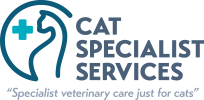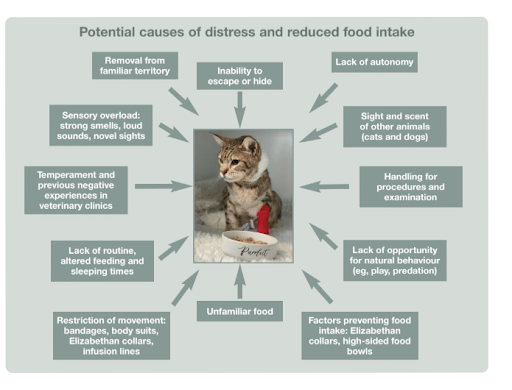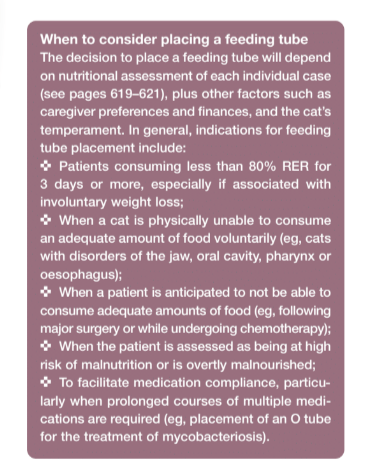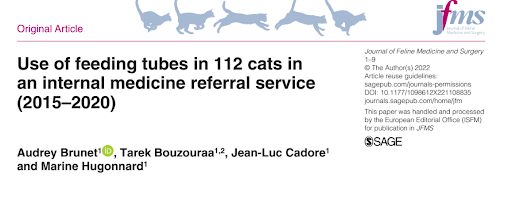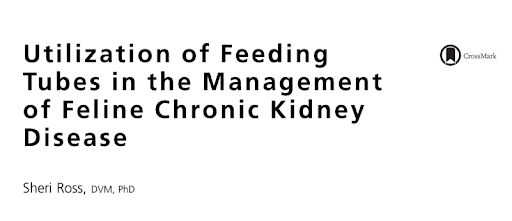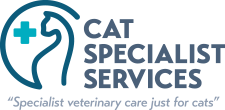Aim
To identify the nature and prevalence of complications following o tube placement and whether any cat factors influence this
Hypothesis was immunocompromised cats and those that had tubes in place the longest would be the most susceptible to infection
Materials and Methods
Case selection
placement of o-tube, date of placement, complications, date of removal
Exclusion
date of removal was not recorded
Data collected
Case signalment
Body weight
BCS
Dx
Date o tube placed
Make of o tube, gauge of tube
Antibiotics used
Presence and nature of complications
Whether discharge was present at the stoma site and the date the discharge was identified at the stoma site and the date the infection was noted
Culture and in vitro antimicrobial sensitivity profile
Whether the cat had a systemic infection present
Whether the cat had a systemic infection present
Whether the cat was receiving glucocorticoids or oncolytic agents
Whether the cat was discharged from the hospital with the tube in place
The date the tube was removed and whether intentionally or not
Whether the cat was euthanized with the tube in place or not
Calculations
Time from presentation to the referral centre to tube placement (days)
Number of days from tube placement to discharge being noted around the stoma site injection (where applicable)
Number of days that the tube was left in place
Discharge defined as secretion from the stoma site which was culture negative or in which cytology did not identify intracellular bacteria or if no culture or no intracellular bacteria identified defined as a secretion that resolved spontaneously without topical or systemic antimicrobials
This was not considered a complication if the only finding identified
Clinically relevant infection was defined as signs of stoma site inflammation in which bacteria were culture or in which intracellular bacteria were identified on cytology of the discharge or antimicrobial therapy was necessary to achieve clinical resolution
Categories of disease
Gastrointestinal
Hepatic
Pancreatic
Traumatic
Neoplastic
Respiratory
Cardiac
Urogenital
Septic
Infectious
Other
If the cat had more than one o tube placed only the first o tube was included in the study
Results
248 cats
Median age 7 years 7 months
Median weight and BCS 4kg and 4
Most tubes placed on the day of presentation or the following day
Type of tube - surgivet, mila , cook or portex
Most common tube 19Fr, 14 Fr
162 cats that survived (162/248 65.3%) the tube was in place for a median of 11 days (range 1-93 days)
78/162 (48.1%) experience a complication
86/248 cats that died (34.7%) death occurred at a median of 4 days after presentation and 11 of these cats had a complication associated with their o tube
Complications associated with having an o-tube in place reported in 89 cats (35.9%) of all cats
The most common complication was dislodgement of the tube
Entirely removed by the cat 19.1%
Dislodged by the cat necessitating removal 12.4%
Dislodge by the cat after repositioning and re-suturing 9%
No cat had more than 1 complication recorded
Infection associated with the tube was the second most complications encountered in the study 33.7%
An additional 45 cats had a discharge at the stoma site that was self-limiting and did not necessitate treatment
The median time to stoma discharge as 6 days (range 1-62 days)
Additional complications
Vomiting in regurgitation of the tube 7.9%
Tube blockage whether it resolved or not 7.9%
Individual cat complications
Temporary laryngeal paralysis
Focal oesophageal rupture
Irritation of the tube site despite grossly normal appearance of the stoma
Displacement of the tube causing a pharyngeal obstruction
Inflamed stoma in the absence of infection
Dry discharge at the tube site in the absence of infection
Mucoid discharge surrounding the tube
Sterile necrosis surrounding the stoma site
Vomiting following tube placement
Anitmicrobials
Given to 167 cats while their o-tubes were in place - 85 before tube placement and 82 after tube placement
Remaining 81 cats did not receive antimicrobials while their e tubes were in place
A single antibiotic was given to 121 cats while 31 cats received 2, 14 cats received 3 and 1 cat received 4
An infection was documented after the placement of o-tube in 30 cats
19 had culture performed of which 1 recorded no growth and was diagnosed on cytology and failure to resolve spontaneously
1 organism in 12 cases E.coli n=5, streptococcus canins or beta haemolytic streptococci n=2 , Pasteurella multocida n=2 , enterococcus spp n=1 , staphylococcus n=1 , pseudomonas aeruginosa n=1
3 cats has 2 organisms isolated ecoli and enterococcus spp n=2 , Pasteurella multocida with staph aureous n=1
2 cats had 3 organisms identified strep , enterococcus and E.coli and candida spp , enterococcus and e,coli
The remaining cat had 4 organisms cultured methicillin resistant staphylococcus ,e coli Pasteurella multocida and Pasteurella pneumotropica
Mila feeding tubes, cats with a discharge at the stoma site and those receiving glucocorticoids or chemotherapy agents had an increased odds of developing a clinically relevant infection necessitating treatment
Cats that died had a decreased odds of developing an infection requiring treatment
Discussion
Complication rate of 35.8% increasing to 48% in cats that survived to discharge
Most frequent was tube displacement followed by a clinically stoma site infection
No cats died or suffered from severe morbidity related to the tube that was not remedied by its removal
Stoma site infection was the second most commonly encountered complication occurring in 12.1% of cases
Most common infections involved commensal organisms rather than primary pathogens or environmental organisms E.coli and Enteroccus spp were the 2 most commonly isolated bacteria these are normal commensals of the GIT tract
O-tubes predisposes to infections with opportunistic bacteria
The normal antimicrobial protective mechanisms of the skin are bypassed once th tube is in place
It also creates a connection between the 2 populations of flora that are naturally separated, altering interactions and potentially allowing overgrowth of certain populations
O tube will cause local tissue irritation, precipitated by chronic micro-movements and foreign body reaction
Self-trauma secondary to discomfort or irritation, could cause secondary wounds or damage to the tube , gross or microscopic allowing bacteria to colonise more readily and potentially from antibiotic resistant biofilms
It is likely that immunosuppression secondary to underlying disease might play a role in development of infection
Administration of glucocorticoids or chemotherapeutic medications was associated with an increased odds of developing a stoma site infection
Unexpected finding with a higher rate of severity of infections with glucocorticoid or chemo - hygiene
Mila tubes higher odds of development of an infection
Gauge of tube did not influence the odds of infection
But view with caution as tube manufacturer and gauge were not recorded in all patients
Cats that died were at a lower risk of o-tube complications including stoma stie infection - cats died after a median time to stoma site infection but median time for infection was 6 days
The length of time that the tube was in place whether the cat was discharged home with the tube still place and the underlying disease process were not associated with an increased odds of infection
Limitations
Retrospective
Lack of standardization of tube placement
Lack of record keeping
Stoma site care not standard
